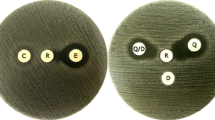Summary
Minimal inhibitory concentrations (MIC) and minimal bactericidal concentrations (MBC) were evaluated of the antimicrobial chemotherapeutics amoxicillin, azithromycin, cefotaxime, ceftriaxone, doxycycline, penicillin G sodium, roxithromycin, and trimethoprim-sulfamethoxazole for 30Borrelia strains from various sources (skin, cerebrospinal fluid, ticks). Of these strains 29 were Lyme disease agents of the speciesBorrelia afzelii (n=12),Borrelia burgdorferi sensu stricto (n=4),Borrelia garinii (n=13), and one was the relapsing fever strainBorrelia turicatae (n=1). Tests were performed in microtiter plates by broth dilution. MIC was determined after 72 hours of incubation by comparing growth control with the antibiotic dilutions by means of dark field microscopy. Strains tested were susceptible against amoxicillin, azithromycin, cefotaxime, ceftriaxone, doxycycline, and penicillin G sodium, partly susceptible to roxithromycin, and resistant to trimethoprimsulfamethoxazole. No statistically significant differences in MIC and MBC were seen among the different antibiotics with the variousBorrelia species.
Zusammenfassung
Minimale Hemmkonzentrationen (MHK), und Minimale bakterizide Konzentrationen der Antibiotika Amoxicillin, Azithromycin, Cefotaxim, Ceftriaxon, Doxycyclin, Penicillin G Natrium, Roxithromycin und Trimethoprim-Sulfamethoxazol (Cotrimoxazol) gegenüber 30 Borrelia-Stämmen verschiedener Herkunft (Haut, Liquor cerebrospinalis, Zecken) wurden im Bouillonverdünnungstest in Mikrotiterplatten bestimmt. Von den Borrelienstämmen, die in dieser Studie verwendet worden sind, waren 29 Erreger der Lyme-Borreliose und zwar die SpeciesBorrelia afzelii (n=12),Borrelia burgdorferi sensu stricto (n=4),Borrelia garinii (n=13), und einer war der RückfallfieberstammBorrelia turicatae (n=1). Die MHK wurde nach 72stündiger Inkubation mittels Dunkelfeldmikroskopie bestimmt, indem die Wachstumskontrollen mit den Antibiotikaverdünnungen verglichen wurden. Die getesteten Stämme waren empfindlich gegenüber Amoxicillin, Azithromycin, Cefotaxim, Ceftriaxon, Doxycyclin und Penicillin G, zum Teil empfindlich gegenüber Roxithromycin und resistent gegenüber Cotrimoxazol. Statistisch gesicherte Unterschiede zwischen den MHK- und MBK-Werten der verschiedenen Antibiotika mit den verschiedenen Borrelien-Stämmen und -Arten konnten nicht gesichert werden.
Similar content being viewed by others
References
Steere, A. C., Hutchinson, G. J., Rahn, D. W., Sigal, L. H., Craft, J. E., De Sanna, E. T. Treatment of the early manifestations of Lyme disease. Ann. Intern. Med. 99 (1983) 22–26.
Steere, A. C., Green, J., Schoen, R. T., Taylor, E., Hutchinson, G. J., Rahn, D. W. Successful parenteral therapy of established Lyme disease. N. Engl. J. Med. 312 (1985) 869–874.
Kristoferitsch, W., Baumhackl, U., Sluga, E., Stanek, G., Zeiler, K. High dose penicillin therapy in meningopolyneuritis Garin-Bujadoux-Bannwarth. Clinical and cerebrospinal fluid data. Zbl. Bakt. Mikrobiol. Hyg. A 263 (1986) 357–364.
Barbour, A. G. Isolation and cultivation of Lyme disease spirochetes. Yale J. Biol. Med. 57 (1984) 71–75.
Weber, K., Neubert, U., Thurmayr, R. Antibiotic therapy in early erythema migrans disease and related disorders. Zbl. Bakt. Mikrobiol. Hyg. A 263 (1986) 377–388.
Frautschi von Saanen, C. Stellenwert der Penicillintherapie beim Erythema chronicum migrans in Hinblick auf Spätkomplikationen. Inaugural Dissertation an der Universität Bern, Schweiz 1988.
Hansen, K., Hovmark, A., Lebech, A. M., Olsson, K., Halkier-Sorensen, I., Olsson, I., Sorensen, L. Roxithromycin in Lyme borreliosis. Acta. Derm. Venereol. 72 (1992) 297–300.
Preac-Mursic, V., Wilske, B., Schierz, G. EuropeanBorrelia burgdorferi isolated from humans and ticks. Culture conditions and antibiotic susceptibility. Zbl. Bakt. Mikrobiol. Hyg. A 263 (1986) 112–118.
Baranton, G., Postic, D., Saint Girons, I., Boerlin, P., Piffaretti, J.-C., Assous, M., Grimiont, P. A. D. Delineation ofBorrelia burgdorferi sensu stricto, Borrelia garinii sp. nov., and group VS461 associated with Lyme borreliosis. Int. J. Syst. Bacteriol. 42 (1992) 378–383.
Ericsson, H. M., Sherris, J. C.: Antibiotic sensitivity testing. Acta Path. Microbiol. Scand. Sect. B, Suppl. 217 (1971).
Pfister, H. W., Preac Mursic, V., Wilske, B., Schielk, E., Sörgel, F., Einhäupl, K. M. Randomized comparison of ceftriaxone and cefotaxime in Lyme neuroborreliosis. J. Infect. Dis. 163 (1991) 311–318.
Author information
Authors and Affiliations
Rights and permissions
About this article
Cite this article
Stanek, G., Baradaran-Dilmaghani, R. In vitro susceptibility of thirtyBorrelia strains from various sources against eight antimicrobial chemotherapeutics. Infection 24, 60–63 (1996). https://doi.org/10.1007/BF01780660
Issue Date:
DOI: https://doi.org/10.1007/BF01780660



